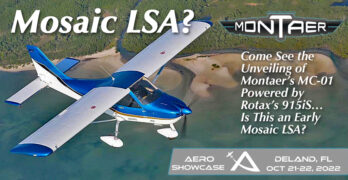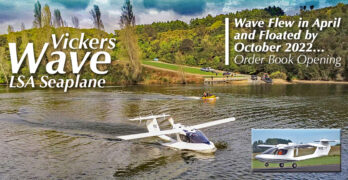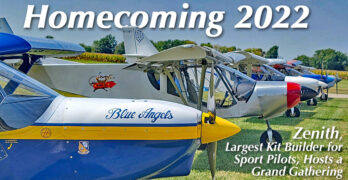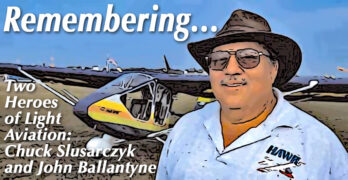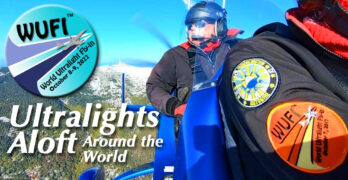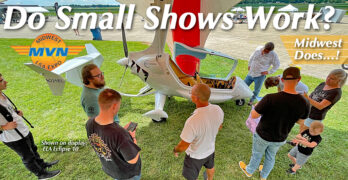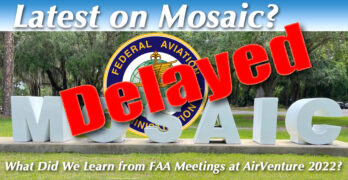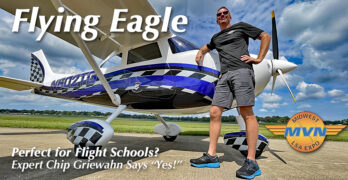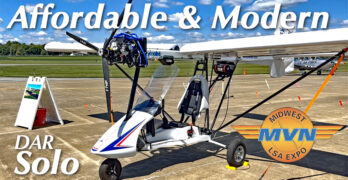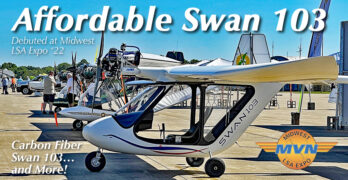When I asked “Mosaic LSA?” in the lead image of this article, was I simply being provocative? Or, is the soon-to-be-debuted Montaer MC01 with Rotax 915iS a forecast of what is to come with Mosaic?
Hopefully the title did get your attention but it asks a legitimate question for buyers of new potentially-Mosaic-compliant Light-Sport Aircraft.
The reason I feel this way is not merely the 141-horsepower engine Montaer designer Bruno Oliveira installed on the nose of his three-door LSA (see earlier review, before 915).
A more significant reason is that this airplane is one of several that may be able to re-declare compliance and get a substantial weight increase. It will already have a powerful-enough engine to lift a heavier load.
So, buyers of this airplane (and I repeat, MC01 will not be the only such choice) may be able to acquire a present-day 1,320-pound LSA and later get it bumped to perhaps 1,600-1,700 pounds, maybe more.
Vickers LSA Seaplane Flew In Spring — By Fall, Wave Tested Its “Sea Legs”
One of the longest-awaited Light-Sport development projects has been Vickers Aircraft’s Wave, a sophisticated amphibious LSA seaplane. Following the media-drenched Icon A5, Vickers in New Zealand took their time to get Wave right.
Remember, seasons are reversed in the Southern Hemisphere. New Zealand is now emerging from winter (during our summer) and is beginning its warmer climate. The summer months in New Zealand are December, January, and February so the weather is getting nice down under.
One of the explanations for the longer development cycle was that Vickers Aircraft was making a massive effort to reduce part count to aid manufacturing and reduce cost. Wave first announced $189,000 but this will likely come in substantially higher …along with everything else you are buying these days. Similarly, A5 arrived on the market more than ten years ago at $139,000 but has risen to beyond $350,000. Some of that could be due to manufacturing challenges, exactly the reason Paul Vickers insisted on taking the time needed to control expenses.
Zenith Aircraft’s 30th Anniversary Homecoming Extravaganza; Company Leads Sector
Shortly after the Midwest LSA Expo each year, a nearby company hosts a homecoming for its builders. Maybe you’ve heard of them: Zenith Aircraft? Truth is, the odds are reasonably good that you’ve either built a Zenith kit, contemplated building one, or flew in one.
For years this company has led the segment I’ve dubbed “Sport Pilot kits” — those kits that a builder can fly using Sport Pilot privileges. Lead by Sebastien Heintz, Zenith continues a long stride ahead of other worthy competitors.
Our Tableau Public view of the LSA and Sport Pilot kit marketplace was recently updated through 3Q2022 — thanks to Datastician Extraordinaire, Steve Beste!
While Van’s RV-12 leads for a single model (47 registered so far in 2022), Zenith is the clear leader in this space. For 2022, the Mexico, Missouri-based manufacturer has already almost matched 2020 and 2021, and those were good years.
Honoring Two Important Light Aviation Pioneers — Chuck Slusarczyk and John Ballantyne
UPDATE Note (10/15/22): I urge all readers to take special note of two comments below that greatly add to the respect I intended to show John Ballantyne and Chuck Slusarczyk. I hope you’ll take the time to read both. —DJ
A Tribute… to Two Heroes
of Recreational Aviation
CHUCK SLUSARCZYK — On September 29, 2022, the sport aviation industry lost one of its best-known innovators, Chuck Slusarczyk (“Slew-zar-chick”). He was 81 years old.
A pioneer in both hang glider and ultralight aircraft industries — founder of Chuck’s Glider Supplies which became known as CGS Aviation — Chuck had worked at NASA Lewis in Cleveland, Ohio.
After striking out on his own, he designed numerous hang gliders and, later, the award-winning CGS Hawk.
Chuck was an inaugural inductee into the EAA Ultralight Hall of Fame. His aircraft are on display in three aviation museums including at EAA and Sun ‘n Fun.
WUFI… A Different Sort of Aviation Event — On October 8 & 9, Thousands of Ultralight Enthusiasts Take to the Sky
While those of us in Florida hangared our aircraft and hunkered down for Hurricane Ian, elsewhere in the world, many pilots were preparing their airplanes and gearing up for one of the biggest aviation events you’ll never see.
This weekend perhaps thousands of light, sport, recreational aircraft owners will take their ultralights (or other light aircraft) into the sky for a kind of “virtual” airshow, except it isn’t computer simulators. It is only virtual in the sense that nearly all aviators will help create an “airshow” without seeing another aircraft. “Analog” might be a better term than virtual.
The innovative concept makes WUFI (on Facebook) about as different from Oshkosh as you can get yet it generates its own high level of enthusiasm.
Note to recreational pilots: YOU can join the action and be part of the world’s largest airshow …largest by virtue of it being spread all over the planet on one weekend!
Midwest LSA Expo Wrap-Up — Metrics Reveal the Strength of These “Sector-Specific Shows”
Sun ‘n Fun does it. EAA AirVenture Oshkosh did it. Why not the smaller, sector-specific shows? Indeed, why not? I refer to reporting of show statistics when the event concludes. In modern vernacular, these are “metrics.”
The likable and longtime manager of the Mt. Vernon, Illinois municipal airport, Chris Collins, has been forwarding some “metrics” from this year’s 14th annual event. Whatever you choose to call the numbers from an event, they provide useful information on how the show performed.
One comment measurement is the number of airplanes sold or the quantity of interested pilots who expressed real interest. Trying to get hard information is like nailing Jello to a wall. We get tidbits and potential but hard facts are hard to assemble. A genuinely interested person ready to make a deal could experience problems right after the event. Some (understandably) need to check with their spouse; that sometimes alters a decision.
Midwest LSA Expo 2022 Presentation — What We Know about FAA’s Mosaic Regulation, with Q&A Session
I am honored that the room was full to standing room only capacity but even that gratifying turn-out at the Midwest LSA Expo 2022 represents a fraction of pilots keen to learn more about Mosaic. I refer to a forum at the event, a talk that has been well attended since I began attempting to keep up with FAA’s latest moves on the new LSA regulation.
For the majority that could not attend in person, the entire talk is featured below. In particular, I think you may enjoy the Question & Answer portion starting at 32 minutes into the video. See the list of questions below for specific times — in case you know most of this but simply wanted to ask a certain question.
I’ve been predicting for months that if FAA was to stay on schedule — a schedule they set — the agency had to announce Mosaic at Oshkosh 2022.
Midwest LSA Expo; Day 3 — Flying Orlican’s M-8 Eagle… a Perfect Flight School LSA?
Problem: The fleet of aircraft trainers in the USA is getting old. The familiar, reliable standard is the Cessna 172. While these are being made brand new, their base cost has risen to half a million dollars. Meanwhile, much more affordable vintage 172s normally have dated instrument panels and the airframe often looks well-worn. Built in the last decade or so, nearly all LSA have fully digital cockpits among other modern features. [Update 9/15/22 — see new info regarding trim. —DJ]
With their goal of getting a good pilot job, flight students that visit schools today want to pursue their training in something more contemporary. They definitely need experience with digital avionics as that’s what they’ll encounter in a professional cockpit.
“LSA are the future of flight instruction [airplanes],” stated Chip Griewahn. Before he sold the business, he operated a very successful flight school in the Savannah, Georgia area called Fly Corps Aviation.
Midwest LSA Expo; Day 2 — DAR’s Solo Is An Affordable and Modern Part 103 Ultralight
Some kind of remarkable thing happened here in Mt. Vernon, Illinois where the Midwest LSA Expo is taking place. Out of the 30 or 40 airplanes on display, no less than three of them are what I’ll call “next generation” Part 103 ultralight entries.
It would be amazing to see three new ones of any sort, but all three of these are modern. They all use contemporary materials yet they have all been shown to qualify for FAA’s simplest regulation.
The three are Chip Erwin’s Merlin Lite, the AVI Swan I wrote about yesterday, and today’s subject: AeroplanesDAR’s Solo. All three are impressive and all three break away from the common Part 103 ultralight using “tube and gusset” construction
Two years ago I reported on the Merlin Lite and the pace of its innovative development has quickened. Chip’s popular entry will soon enter into a new production agreement so the airplanes will be assembled here in the USA by a longtime reliable expert.
Midwest LSA Expo; Day 1 — The Sleek, Affordable, Foldable, Trailerable Swan 103
While I have been familiar with AVI’s Swan for several years, having earlier seen it at the German Aero show, this was a first appearance for Swan in the United States. What’s brand new is the Swan 103 model made specifically for FAR Part 103. The new model made its American debut at the Midwest LSA Expo. [September 9 UPDATE: Tom Bartlett’s contact info has been added; see “Article Links” toward the end of the article. —DJ]
This is the 14th running of the popular show in Mt. Vernon, Illinois. It’s what I call an intimate, sector-specific show. By that I mean it is all the sort of aircraft I cover on this website… Light-Sport Aircraft, Sport Pilot-eligible kit aircraft, and ultralight aircraft.
Thursday is regarded as one of the slower days of the three-day event — some vendors only attend on Friday and Saturday. Yet at least two airplanes and maybe three or four were sold on opening day.
- « Previous Page
- 1
- …
- 17
- 18
- 19
- 20
- 21
- 22
- Next Page »


